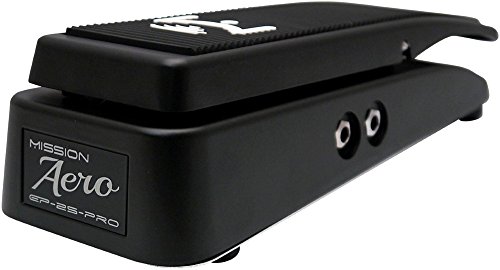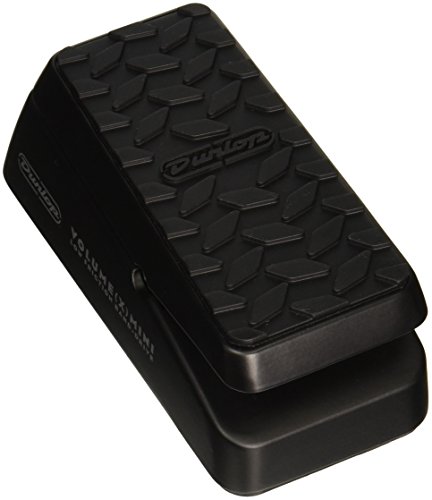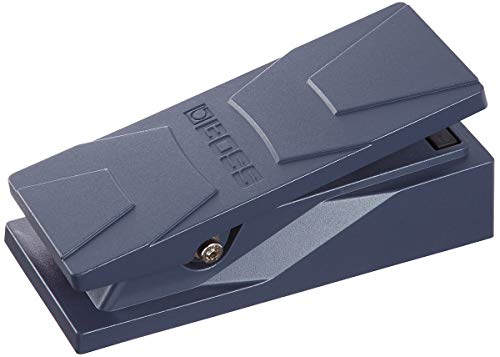6 Best Guitar Expression Pedals
If you’re looking for the best way to have real-time control over your instrument or pedalboard effects, then you’ve come to the right place. Expression pedals come in a variety of different shapes, sizes, and with different output functions and polarities, making it frustrating to choose the one that is right for your purpose.
That’s why we’ve researched and rounded up the 6 best expression pedals that you can buy today to fit your exact needs.
Top Picks: 6 Best Expression Pedal Reviews
1. Mission Engineering EP-25 Pro Aero Expression Pedal - Best Overall
Specifications
Size: 11″ x 4″ x 3″
- Type: Passive, Dual Expression
- Material: Aluminum
- Impedance: Dual 25K Ohm Linear
Mission Engineering is a brand that’s been creating industry-standard expression pedals for many years now. With sturdy, durable designs and versatile, expressive functionality, all of their pedals showcase amazing attention to detail. Their newest release, the EP-25 Pro Aero features a new and unique expression pedal design that’s aimed to provide greater sweep-area and easier movement.
The EP-25 Pro Aero features two ¼” outputs that can be connected to your pedals for dual expression functionality. It requires TRS cables instead of TS, and both the pedals will be controlled simultaneously. This is very useful as, for example, you can connect two different modulation effects, or a delay, and control them with a single pedal. According to popular YouTuber Henning Pauly, aka EytschPi42 (1) :
Mission Engineering makes THE pedals for every professional board, and the new Aero design is very intriguing, making it more comfortable.
Since different pedals work with expression pedals differently, the EP-25 has independent polarity switches for each output, so you can select the setting that matches your pedal. With a 25k Ohm impedance, it offers smooth performance and can work with a variety of different instruments, from guitars to keyboards.
If you’re looking for the best expression pedal, then the Mission Engineering EP-25 Pro Aero is it. With an extended sweep region that allows for comfortable foot movement, a rugged, aluminum design, and dual expression outputs with independent polarity switches, the EP-25 is simply the best guitar expression pedal.
2. Moog EP-3 Expression Pedal - Budget Pick
Specifications
Size: 4” x 3.5” x 12.5”
- Type: Passive, Single Expression
- Material: Plastic
- Impedance: 50K Ohm
Moog is most popularly known for making analog synthesizers, but the Moog EP series of expression pedals have long been used by many famous musicians. The latest version, the Moog EP-3, is aimed to offer a simple and portable solution to expression functionality for a variety of instruments and pedals.
The EP-3 has a single ¼” jack for connection, and it comes with a 6.5’ cable included to connect your pedal or instrument. There’s a polarity switch at the bottom that lets you reverse it, ensuring full compatibility with almost all instruments and pedals, from keyboards and analog synthesizers to guitars and effect pedals.
The pedal is made of plastic, but it’s thick, rugged, and quite durable, with a compact but easy to use treadle on top. Its movement is smooth, and there’s a knob to adjust its range of motion as precisely as needed. With 50K impedance, it works smoothly with whatever instrument it’s connected to.
If you’re looking for a great expression pedal on a budget, then the Moog EP-3 is the best choice. With professional quality at a very affordable price, great compatibility with most instruments, and easy, smooth expressiveness in a rugged and portable pedal, Moog have made one of the best expression pedals for guitar players.
3. Jim Dunlop DVP4 Guitar Volume Pedal - Most Portable
Specifications
Size: 2.5” x 3” x 6”
- Type: Passive, Single Expression
- Material: Aluminum
- Impedance: 10K Ohm and 250K Ohm
Dunlop is a well-known name in the world of guitar effects pedals, and their series of expression pedals have been widely used as well. The Dunlop DVP4 volume guitar pedal, their newest release, comes at a size approximately half that of the earlier DVP3, with added functionality and more flexibility to function as a volume pedal, guitar or any other instrument, and also an expression pedal.
There are three ¼” jacks on the DVP4 - Input, Output, and Aux. The Input jack is used to connect your guitar and the Output to an amplifier, when it is being used as a passive volume control pedal. If it is being used as an expression pedal, you can connect to the Aux jack, where it can be connected to either a tuner pedal, or control the FX parameter of a pedal. An internal trim pot can be used to set its sensitivity, and the polarity can be reversed as well.
The DVP4 expression pedal is one of the smallest expression pedals, so it can easily be carried around wherever and fit on most pedalboards. With different output jacks and different impedances, as well as a polarity switch, it can work with a variety of different instruments and pedals easily, and the torque of the treadle can be adjusted using a screwdriver for smooth foot movement.
If you’re looking for the most portable expression pedal, then the Jim Dunlop DVP4 is your best option. With a small form factor of just 2.5” x 3” x 6” and such versatility packed into it with 3 output jacks, adjustable tension, a lightweight aluminum chassis, and functionality as both a volume and expression pedal, the DVP4 is a fantastic choice for professionals and amateurs alike.
4. BOSS EV-30 Dual Expression Pedal - Most Versatile
Specifications
Size: 7.5” x 3.6” x 3.18”
- Type: Passive, Dual Expression
- Material: Die-Cast Aluminum
- Impedance: 10K Ohm
Boss, a Roland brand, is basically a legendary name in the world of guitar effects, having produced iconic pedals for many decades now. Their earlier expression pedals like the FVH were very popular, and now, they have launched the Boss EV-30, which can simultaneously control two devices and offers a more compact, portable form factor for traveling.
The Boss EV-30 features two ¼” jacks to connect to two pedals, being able to simultaneously control both as an expression pedal. There are independent minimum knobs as well, so you can set the exact desired range of each effect that you control. For example, you could control a pitch shifter and a modulation together, with different range settings for each. There’s even a polarity switch to ensure compatibility with almost all pedals, and to inverse the range of the foot pedal. According to Tom Quayle from Dawsons Music (2):
The EV-30 is the perfect choice for those with packed out setups who don’t want to compromise when it comes to deft tone control.
The pedal is built with die-cast aluminum, so it’s very rugged and durable, and yet compact enough to fit on most pedalboards. It’s compatible with a wide range of instruments, from guitars and keyboards to MIDI controllers, and its foot treadle can be adjusted with a screw for smooth movement and comfort.
If you’re looking for an amazing dual expression pedal, then the Boss EV-30 is a great choice. With independent knobs to control each output, a polarity switch, a compact and durable chassis, and wide compatibility, the EV-30 is another fantastic product by Boss.
5. Korg XVP-20 Expression/Volume Pedal
Specifications
Size: 3.54″ x 10.55″ x 2.44″
- Type: Passive, Dual Expression
- Material: Aluminum
- Impedance: 50K-100K Ohms
Korg has been making renowned keyboards and analog synthesizers for many decades now, and they make great quality expression pedals to go alongside them. The original XVP-10 was a big hit, but now they’ve launched the Korg XVP-20 to offer even more features and flexibility to aspiring keyboardists and professionals.
The XVP-20 has a total of five jacks - stereo ¼” inputs, stereo ¼” outputs, as well as one ¼” expression jack. This lets you use it in a variety of ways; you can connect your keyboard or another instrument to the input and then use it as a volume pedal, or you can connect a CV port or expression jack and use it as an expression pedal, or both even. It’s a very versatile pedal, with adjustable range too, using a minimum volume knob on the back of the pedal.
The pedal features a tough aluminum design that’s meant to last many years of foot-stomping without breaking a sweat. The torque of the foot pedal, which features a rubberized grip, can also be adjusted using a screw, ensuring smooth movement. It’s very easy to keep your foot on the pedal and expressively control your music due to its larger size.
If you’re looking for a fantastic, versatile volume and expression pedal for your keyboard or synthesizer, then the Korg XVP-20 is a great choice. With a sturdy, metal chassis, a host of connectivity options, volume range control, and a classic pedal design, the XVP-20 does everything you would need for full expressivity.
6. Yamaha FC7 Volume Expression Pedal
Specifications
Size: 2.3” x 4.5” x 9.8”
- Type: Passive, Single Expression
- Material: Plastic, Metal Base
- Impedance: 50k Ohm
Yamaha is a renowned Japanese company that manufactures a variety of products, from guitars, keyboards, and pianos, to effects and volume and expression pedals. The FC7 is one of their most popular pedals that can be used for both volume and expression, and offers a compact and affordable way for exploring new musical creativity.
The FC7 features a super simple design, with an inbuilt, 5-foot long cable with a ¼” TRS plug to use with your instrument or pedal. This allows you to simply connect your device and start using it easily without configuration. For more versatility though, there’s a ‘fortissimo’ function, which lets you apply more pressure on the pedal and accentuate your performance as needed. There’s a total of 30 degrees of movement possible here, so it allows for great expressiveness.
The pedal is built with a rugged and durable chassis that’s made of heavy plastic, and a metal base plate for additional support. It’s very compact, so it can easily fit on any pedalboard, and you can easily connect multiple FC7s together for easier performances. You can adjust the angle of the pedal as well, to ensure a comfortable usage whether you’re standing or seated while playing.
If you’re looking for a simple and great expression pedal for your keyboard or guitar pedal, then the FC7 is a great choice. With easy to use, plug and play connectivity, an inbuilt 5-foot cable, a fortissimo function, and a durable and compact design, the FC7 offers all the basics that keyboard and synth players might need from such a device.
Buying Guide: How To Pick The Best Expression Pedal For You
If you’re still confused about what to get, then here are some important tips that you should keep in mind before buying your first expression pedal:
Type
Expression pedals generally come in two types: Passive and Active. Passive pedals do not require any power, and hence they can simply be connected to an instrument and function as needed. An active pedal requires external power, however, and it functions only when provided with enough power as it contains a buffer that can boost your signal and prevent any signal loss.
Passive expression pedals are preferred as they do not require a power supply and function perfectly only on the basis of their potentiometer.
However, if a passive pedal is being used as a volume pedal, it may cause some signal loss based on its position in your signal chain due to their high impedances. If you wish to use it like that, you may consider getting an active pedal instead so it can act as a buffer and maintain a high-quality signal.
Impedance
The pedals on this list have a wide range of impedance values, and you may wonder why that is relevant to you. Impedance, the resistance offered by the pedal to the signal, is very important in determining exactly where the pedal should go on your pedalboard and the chain of effects.
An expression pedal is usually connected to an EXP jack on an effect, wherein it only controls the FX parameters of the pedal, and your guitar signal does not pass through it. In such cases, the impedance does not play a major role.
Low impedance pedals work best at the end of your signal chain, while high impedance ones should be at the beginning.
However, if you are using it as a volume pedal as well, then the impedance is very important. When using a low impedance pedal, it should be placed near the end of the chain because the signal has been processed and is already a low impedance signal. On the contrary, the output from your guitar has a relatively high impedance, and hence a high impedance pedal is needed to be used at the beginning of a chain to prevent signal loss (3).
Size And Material
When buying an expression pedal, you have to be sure that it’ll fit in your existing pedalboard and also be comfortable for you to use. Generally, these pedals come in a lot of different shapes and sizes, such as the unique Mission Engineering Pro Aero, which has a curved treadle and larger sweep area, or the Dunlop DVP4, which is much smaller and can easily fit on most boards. Hence, pick one that’s comfortable and will also be easy for you to carry around.
Some of the pedals on this list are built with plastic to be on the cheaper side, while others are made with metals like aluminum. If you want one long-lasting pedal that can survive for many years and go on tours without getting damaged, we’d recommend getting an expression pedal with a metal chassis. But if you’re just beginning and you need to try one out, then you may pick a cheaper one as they function equally well.
FAQs
No, a volume pedal is not the same as an expression pedal as they perform different functions. Sometimes, the same pedals may be used for both purposes, but their functions are separate. A volume pedal is used to control either your input volume or your output volume, whereas an expression pedal is used to control an FX parameter of a pedal such as modulation, delay, reverb, etc.
An expression pedal is used to control expression functions of different effects and guitar pedals. It is essentially a potentiometer, and it alters the value of a given signal within a range, from a specified minimum to a maximum. This lets you do various things, such as control the delay time, reverb mix, pitch shift, wah, and much more. By letting you control these pedals in real-time, you can add great expressiveness and creativity to your performance.
No, a wah pedal can not be used as an expression pedal as such. Since a Wah is an effect in itself, a wah pedal, such as the Dunlop crybaby, is used to control that effect and it works as an expression pedal for a specific effect. Wah pedals generally cannot be connected to control the expression of another pedal, and moreover, they have higher impedance values since they are generally first in the signal chain.
You can hook up an expression pedal to any compatible pedal on your board using the appropriate TS or TRS cable. Compatible pedals, such as many Boss pedals, generally have special EXP jacks that are designed to connect expression pedals. Once connected to the appropriate effect, you should refer to its manual to understand how to control a particular parameter and set the minimum and maximum range.
References
- A gold brick? Nope, it’s an Aero Expression Pedal from Mission Engineering!. Retrieved from: https://youtu.be/K63mm-yEXV4?t=63
- Perfect Gifts for Guitar Players | Under £100 | Boss EV-30 Dual Expression Pedal. Retrieved from: https://youtu.be/zFDe8CzOK5c
- Buffers, impedance, and other internet lore. Retrieved from: https://www.mrblackpedals.com/blogs/straight-jive/6629774-buffers-impedance-and-other-internet-lore







